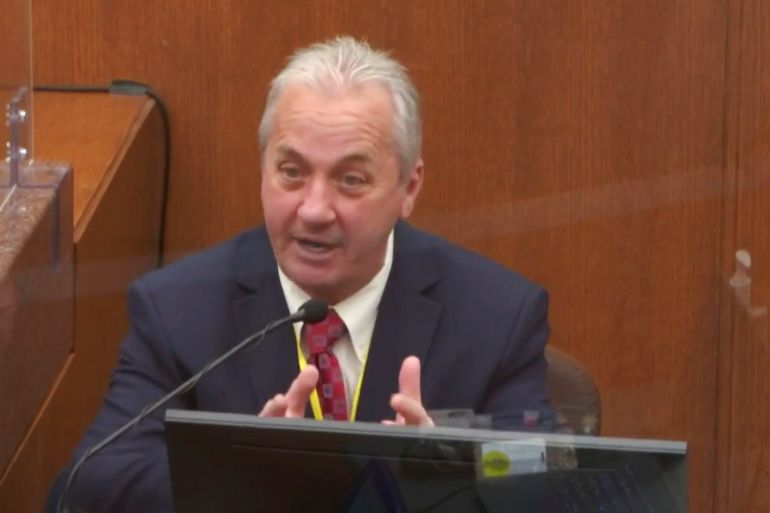Senior officer at Chauvin trial: Knee on neck is ‘deadly’ force
In the trial of former Minneapolis officer Derek Chauvin, the head of the police department’s homicide division offers harsh testimony.

Kneeling on the neck of someone who is handcuffed and in the prone position is “top-tier, deadly” force and should not be used, the head of the Minneapolis Police Department’s homicide division testified on Friday at former officer Derek Chauvin’s murder trial.
“If your knee is on a person’s neck, that can kill him,” said Lieutenant Richard Zimmerman, adding that when a person is handcuffed in the prone position, “your muscles are pulling back … and if you’re laying on your chest, that’s constricting your breathing even more”.
Keep reading
list of 3 itemsProsecutor: Chauvin’s knee on Floyd was ‘grinding and crushing’
‘Stakes extremely high’ as US readies for Chauvin trial
He offered harsh testimony against the way his former colleague and other officers at the scene restrained Floyd.
“Pulling him down to the ground face down, and putting your knee on the neck for that amount of time is just uncalled for,” Zimmerman said. “I saw no reason why the officers felt they were in danger, if that’s what they felt, and that’s what they would have to feel in order to use that kind of force.”
Chauvin, 45 and white, is accused of killing Floyd by pinning his knee on the 46-year-old Black man’s neck for 9 minutes, 29 seconds, as he lay face-down in handcuffs. Floyd had been accused of passing a counterfeit $20 bill at a neighbourhood market.
His death triggered large protests around the United States, scattered violence and widespread soul-searching over racism and police brutality. The since-fired Chauvin is charged with murder and manslaughter, and the most serious charge against him carries up to 40 years in prison.
Zimmerman arrived just before 10pm, about half an hour after Floyd had been declared dead at a downtown hospital, and said he helped ensure that evidence was properly secured and any witnesses were found.
Zimmerman said officers were responsible for the care of anyone they arrested and are trained to give first aid to an injured or distressed detainee even if they know an ambulance is coming.
“His safety is your responsibility, his wellbeing is your responsibility,” he told the jury.
He described how officers are trained only to respond to any threat with a proportionate amount of force.
“Once a person is cuffed, the threat level goes down all the way,” Zimmerman told the jury after prosecutors called him to testify. “They’re cuffed. How can they really hurt you, you know?”
And he warned of the dangers of leaving a person in a prone position.
“Once you’ve secured or handcuffed a person you need to get them out of the prone position as soon as possible because it restricts their breathing,” he said.
In cross-examination, Zimmerman agreed when Eric Nelson, Chauvin’s lead lawyer, pointed out that the lieutenant does not train officers in how to use restraints and that as an investigator he has to use force less often than a patrolling officer.
Zimmerman’s testimony came a day after a Minneapolis police supervisory sergeant who was on duty the night George Floyd died testified that he believes the officers who restrained Floyd could have ended it after he stopped resisting.
David Pleoger testified on Thursday that officers are trained to roll people on their side to help with their breathing after they have been restrained in the prone position.
“When Mr Floyd was no longer offering up any resistance to the officers, they could have ended the restraint,” Pleoger said.
“And that was after he was handcuffed and on the ground and no longer resistant?” prosecutor Steve Schleicher asked.
“Correct,” replied Pleoger, who is now retired.
On Friday, Minneapolis police sergeant Jon Edwards, the overnight supervisor the night Floyd died, said he secured the scene at the request of Pleoger, who was still at the hospital with Floyd. Edwards said Pleoger told him the encounter had the potential to become a “critical incident,” which could mean someone died or was seriously injured.
Edwards, who was not Chauvin’s supervisor, said he did not have details about what happened at that time but arrived to find two of the officers involved in Floyd’s arrest – Thomas Lane and J Kueng – still at the intersection. He had them put up crime scene tape.
He called other officers to the scene and instructed them to go door to door looking for witnesses. Edwards said he learned later that Floyd had died, after homicide investigators arrived.
The defence has argued that Chauvin did what he was trained to do when he encountered Floyd last May and that Floyd’s death was caused by drugs, his underlying health conditions and his own adrenaline. An autopsy found fentanyl and methamphetamine in his system.